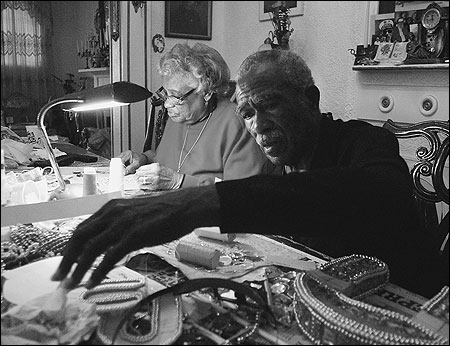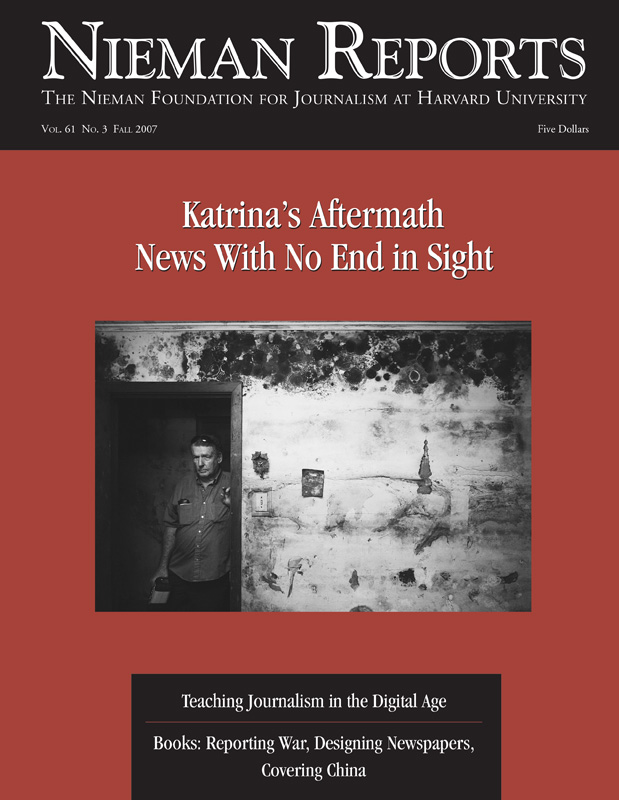
In his New Orleans Journal, appearing in The New Yorker, journalist Dan Baum has written about Miss Joyce, now the widow of Mardi Gras Big Chief Allison “Tootie” Montana. She is pictured with her husband in February 2004 as they worked together on his Mardi Gras suit. Photo by John McCusker/The Times-Picayune.
For the first year after Hurricane Katrina, New Orleans was the story every journalist yearned for. God forbid any great American city should befall such a calamity but, once it happened, the aftermath produced some of the more complex and fascinating stories of a career. It had everything: complete and epic destruction; government incompetence from city hall to the statehouse to the White House; the greatest engineering disaster in American history; an internationally acclaimed artistic heritage in peril; the greatest city planning challenge in modern times, and a complex racial overlay (or, as they say in New Orleans, “It ain’t about race, it’s about shade”). And everyone was a quote machine, from the Creole chef to the French Quarter strip-club hawker to the rasping piano professor who told me, “N’awlins has been traumaticalized.”
That was then. Today, nearly two years after the dikes crumbled and Lake Pontchartrain roared into the city, it’s a lot harder to tell that story. It’s harder because we’ve done our job well. Journalists have described why the levees failed and covered every step of the Herculean effort to rebuild them. We’ve chased Mayor C. Ray Nagin for interviews, usually fruitlessly, and tried to understand why the city reelected him. We’ve chronicled the state’s feckless program to repatriate residents who are desperate to come home. We’ve reported on the city’s alarmingly high level of depression, suicide and criminal violence. We’ve tried to document and deconstruct the chaos during the unforgettable week after the storm, such as the hospital patients who were allegedly euthanized in Memorial Medical Center and the police who allegedly gunned down civilians on the Danziger Bridge. We’ve told every story we could uncover in a city that seemed to offer up a poignant and comic drama behind every flood-warped front door.
Nearly two years later readers and viewers and listeners — who suffer from the national affliction of NADD (news attention deficit disorder) — have moved on, telling us that they’ve heard it already. They have Katrina fatigue. This circumstance ups the ante for journalists who believe that the aftermath of Hurricane Katrina in New Orleans and along the rest of the Gulf Coast is important and that the rough draft of history is still in progress.
Anyone who visits New Orleans knows the story is far from over. Much of the city is still a disaster zone, where exuberant tropical growth has overtaken abandoned neighborhoods and returning residents live like frontiersmen in a wilderness. “I’d move back, but nothing’s reopened in my old neighborhood. And I don’t want to drive five miles to Jefferson Parish to fill up my tank or buy an ice cream,” the vice president of a bank in devastated New Orleans East told me on a flight out of the city recently.
How do journalists continue to make this catastrophe interesting and relevant for our audiences? There’s no easy answer. As they say, the low-hanging fruit is gone. We look longer for a new angle, spend more time on the phone, and ask friends of friends of friends what’s new. Fortunately, in a city as eccentric and kaleidoscopic as New Orleans, the fresh stories are still there.
- The New York Times found a communal organic farm for urban storm evacuees in central Louisiana started by a wealthy Canadian who called it “an African American version of ‘Green Acres.’”
- Journalist Dan Baum, in his wonderful New Orleans Journal for The New Yorker, introduced us to Big Mike Ricks at Perry Walker High School; Miss Joyce, the widow of longtime Mardi Gras Indian “Tootie” Montana, and took us into Mickie Bee’s, the only bar in the Lower Ninth Ward.
- NPR stringer Eve Troeh reported on the heartening phenomenon of “volun-tourism,” whereby visiting conventioneers and tourists from across the country add a couple of days to help build houses in the flood zone.
The stories are there. Reporters just have to look for them harder. And though we rarely hear from people anymore who want to thank us for remembering New Orleans, we certainly hear that from locals. They’re grateful they have not been forgotten.
I was struck by something that a local journalist told NPR when we did a story on the plethora of disaster tours that New Orleanians now give to visitors. “Our version of Katrina fatigue is different. It’s the fatigue of struggling to survive, to get back to where we were, to really establish a life again,” said James O’Byrne, features editor of the New Orleans Times-Picayune. He lost his family home in Lakeview to the floodwaters. “So it’s painful for us when we hear people say, ‘We’d really like to forget about this and move on to something else.’ Well the truth is we’d really like to forget and move on to something else. But we can’t. Because this is where we live and this is our home and this is our struggle.”
John Burnett is an Austin-based correspondent for National Public Radio, who has covered Katrina since the night it struck until the present.



